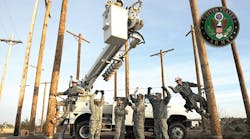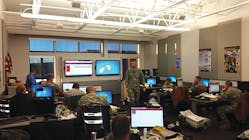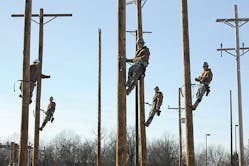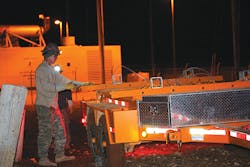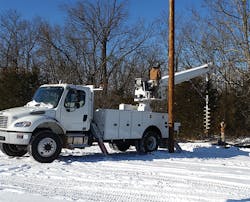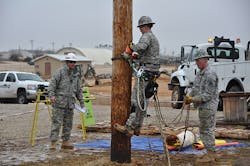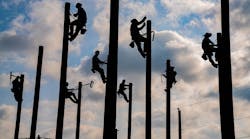If he could look nine years into the future, Staff Sgt. Robert Pepperling knows exactly what he will be doing — working as an apprentice lineman. As one of the first graduates of the U.S. Army’s new Power Line Distribution Course (PLDC), Pepperling plans to apply for a job at a utility as soon as he is released from active duty.
“I told my instructor that this is what I want to do when I get out — find a utility company that needs linemen,” he said. “I like hard work better than sitting at a desk, and, being from Oregon, I love working outside.”
Since the 1950s, the Army has trained soldiers to set up and maintain power plants in war-torn areas. Once the plants were up and running, however, the soldiers were not trained in depth on how to distribute the power, until now.
Three instructors joined forces to launch a new eight-week, hands-on, intensive PLDC at the U.S. Army Prime Power School (USAPPS) at Fort Leonard Wood, Missouri, U.S. The Army created the school for two key reasons:
• To train soldiers to operate and maintain power distribution systems during their wartime mission
• To accomplish assigned missions domestically.
Typically, it can take up to seven years to create a new training program within the Army, but the USAPPS launched the new PLDC in less than one year with the help of the Southeast Lineman Training Center (SLTC), according to Sgt. 1st Class Rustin “Nemo” Owen, a training developer and instructor for the program.
“It is the most awesome feeling in the world,” said Owen, who will retire in January 2016. “Making this course for the Army was always a dream of mine, and it’s the capstone of my career. The other two instructors and I had a passion for building this school, and we are all excited to see it up and running.”
As the largest line worker training center in the nation, the SLTC has more than 75 acres of training grounds in Trenton, Georgia, U.S., and trains more than 600 students a year through its 15-week electrical line worker program.
“SLTC’s strong reputation within the utility industry adds a great deal of value to the training and credentialing that the graduates of PLDC receive from the course,” said James Lake, a former staff sergeant with the 249th Engineer Battalion and SLTC’s lead on the contract with the PLDC.
Training Soldiers
On March 5, 2015, eight soldiers graduated from the first class, including Pepperling, who first entered military service in the National Guard. After focusing on terminal high-altitude area defense systems and generator operation, he yearned to learn about power generation. The Army then offered him a slot for the U4 lineman school following six years of active duty.
“I jumped at it and fell in love with it,” he recalled. “It was an awesome refresher. I learned everything, from power generation all the way to building a distribution line. We can run the power and set up the transformer to the houses, and secondary all the way down to the meter box.”
Pepperling is also a graduate of the Army’s 12-month Prime Power School, which moved from Virginia to Fort Leonard Wood five years ago. While attending this school, which was born out of the Army’s nuclear power program, he not only learned about power generation and how to maintain power plants, but he also earned 32 hours of college credit.
With about 30 students per class, the Prime Power School is offered two to three times per year. The full-time, yearlong course is divided into three basic phases. The first phase is focused on academics, in which the students learn about mathematics, physics, and electrical and mechanical engineering. During the second phase, students learn how to construct, test, maintain and operate the diesel power plants within the Army system. In the final four months, the students enter into a skill identification phase, in which they are placed in one of three groups: electrical, mechanical or instrumentation maintenance.
In the past, the Army sent the active-duty soldiers to Texas to Sheppard Air Force Base’s electrical systems apprentice course for a six-week class along with Army reservists. However, the problem was this course was often much too basic for the Prime Power graduates, who were ready for a more advanced level of training, Owen explained.
“The Air Force program was an initial entry training course, similar to a pre-apprenticeship program,” Owen said. “It was designed to bring someone off the street, teach them the basics and then invite them back for more advanced courses later. For example, during the Air Force training, students were learning about Ohm’s law and the basic concepts of electricity, but in Prime Power School, they were beginning electrical and mechanical engineering courses and were way
past Ohm’s.”
Creating a New School
In 2013, to help provide Prime Power School graduates with advanced training on how to build, maintain and operate an overhead distribution system, the Army selected three subject-matter experts — Owen, Sgt. 1st Class Aaron Sanders and Sgt. 1st Class Jonathan Blake — to serve as instructors for the new PLDC program at Fort Leonard Wood.
Learning about line work from three seasoned veterans was invaluable, Pepperling noted.
“The curriculum definitely took a backseat to these instructors,” he said. “The Army handpicked the most experienced guys, and their knowledge base far surpassed what we could have learned from another instructor. It was a real confidence booster hearing them talk about their experience in the field.”
While these three sergeants worked with the SLTC on building the curriculum for the course, the Delta Company 249th Engineer Battalion of Army Reserve linemen set 40 poles to construct the training facility.
“Our guys have a lot of experience setting poles, and we wanted to help them out,” said Sgt. 1st Class Scott Gervasio of Delta Company. “This is an awesome school, and our rodeo team came to Fort Leonard Wood to finish building the grounds for it.”
After the curriculum was finalized and the training grounds were ready, the instructors then invited the top graduates of the Prime Power School to apply for the new PLDC. At the Prime Power School, soldiers routinely took technical exams and learned how to measure, diagnose, calibrate and repair systems. As such, the program often attracts math, engineering and electronics experts. However, the distribution school is focused not only on technical expertise — which is where alphas shine — but also on physical fitness and actual line work, Pepperling explained.
For the new PLDC, the selection process is based on three major factors: grades, having no fear of heights and physical ability. The instructors also took into account whether a soldier had a prior injury or medical condition that would prevent him or her from doing line work.
“They do two minutes of push-ups and sit-ups, and a 2-mile run during the physical fitness test,” Owen said. “You can find their strengths and weaknesses in there. There are some soldiers who do not do the run but instead do the walk because of knee or ankle problems. Line work is hard on the lower body.”
To do the fear-of-heights test, the instructors take them about 40 ft up a 90-ft airfield lighting tower with 100% fall protection.
“We have them lean back on the fall protection and do simple tasks like touching their nose,” he said. “You want to make sure that they can still think straight when working at a height. You can identify people scared of heights at 15 ft if they are hugging the ladder or shaking really badly. Then, you ask them to come down.”
Participation in the course is strictly voluntary, and the soldiers have the opportunity to come back to the course at a later date if they are not selected to attend upon USAPPS graduation.
“We are only trying to have the top participants in the course, and we want to make sure that they want to be here to make the course successful,” Owen said.
Taking a Hands-On Approach
Those soldiers who are accepted into the program are trained in several different modules of instruction such as overhead power line distribution, underground systems, digger derrick and aerial truck operation, and secondary power distribution.
Approximately 70% of the course is hands on — whether it is climbing, truck operation or actual construction. This approach has many training benefits for the soldiers, said Sgt. 1st Class Aaron Sanders, who formerly served as an instructor at Sheppard Air Force Base.
“By using the hands-on technique of learning, they learn at a higher level than just being presented with the information in a classroom,” Sanders said.
For example, the soldiers learn how to dig holes and load, transport and set poles using the trucks and heavy equipment. In addition, the instructors teach the students to do underground distribution, build risers and pull cable through conduit.
“In the underground portion of the course, we have two underground vaults, and the students have to take an overhead distribution system underneath a road, through two vaults and then back up on the other side,” Sanders said. “They also receive fault recognition training, and learn how to terminate and splice cables inside a vault, and test atmospheric conditions inside a confined space.”
In addition, the instructors spend the first two weeks teaching 67 hours of climbing techniques — from ascending and descending safely to learning and trusting their equipment. The soldiers also learn different work positions, such as circling and performing different tasks on the pole to get comfortable with the height and the equipment.
“When they come to us, none of them have ever climbed a pole before,” Sanders said. “Most of the feedback that we have received is that the students have been receptive to the hands-on training and enjoyed the climbing portion of the course the most.”
For Pepperling, learning how to climb was the most challenging part of the entire eight-week course. During his childhood, he had no fear of heights. In fact, he grew up 5 miles from a lake, and jumped off bridges and cliffs into the water below for fun. However, working 40 ft off the ground on a moving pole was another story.
“It doesn’t matter how confident you are, the first time you get up there, you are terrified,” Pepperling said. “I was scared for the first week of climbing to 40 ft. And then they kicked it up a notch, and I had to climb to 60 ft. You have to have your head screwed on tight to do this type of work. I have a lot of respect for the guys who work that high up with the wind moving. Those guys are tough, and I’m proud to be one of those guys.”
In the first week, he said he went up about 6 ft, circled around the pole, leaned out to the left and right, and then came back down. While no one had an issue with climbing to this height, all of the soldiers’ knees started shaking at about 18 ft. Once they get comfortable with climbing to this height, then they go all the way up to the top of the pole.
During the climbing portion of the course, the soldiers not only learn to ascend and descend the pole, but also to use fall-protection equipment safely, change out crossarms, perform a hurt-man rescue and navigate around obstructions. Every day, the soldiers climb poles for an hour to two.
“You climb every day up and down 40-ft poles, and sometimes you climb up 60 ft,” Pepperling said. “It did a number on me because I’m 32 years old, and I was pretty tired by the end of it.”
Owen said the course is very fast-paced, and they are often worn out by the time the soldiers return to their assigned units. Every day consists of both classroom and hands-on training, and the eight soldiers must work in two-person teams to perform exercises in the training yard.
Putting Soldiers to the Test
At the end of the course, for a culminating event, the students spend five days constructing a distribution system. As part of this training exercise, the students must work in two- or four-person teams to frame and set 13 poles according to spec and staking sheets, hang transformers, string wires, and install service drops and streetlights. Near the end of the culminating event, the instructors provide the students with a realistic disaster response scenario and release them for a portion of the day.
“After the soldiers leave, we go to work on the distribution system that they spent a long time building,” Sanders said. “We cut poles in half, put debris on the lines and around the poles, and cut crossarms to simulate damage by a tree branch. It takes us all afternoon, and we call them back in the evening to do their damage assessment, come up with a plan of action on how to repair the damage and then make the repairs.”
Typically, it takes the soldiers about six hours to complete the restoration. For example, in the last class, the students did not wrap up their work until 11:45 p.m., Sanders said. The instructors then evaluate the soldiers individually and as a team.
“Because all of these soldiers are assigned to the 249th Engineer Battalion, one of their missions is to support the Army Corps of Engineers and FEMA in disaster response,” Sanders said. “By having them build a distribution system, and then having us simulate a storm, and having to go and fix it, it has given them insight into what they will actually be doing as part of the national response framework.”
To wrap up the eight-week session, the instructors ask the students to compete in a mini rodeo two days prior to graduation. The events are all based on the International Lineman’s Rodeo format. The soldiers are required to climb poles and simulate energized and de-energized work on circuits.
As a cumulative practical exercise, the rodeo showcases the soldiers’ skills and builds their confidence, Sanders said. It also demonstrates what they have learned throughout the course and exposes them to a lineman’s rodeo format in preparation for the opportunity to compete in rodeos across the country.
Unbeknownst to the competitors, at the last rodeo, the instructors invited local utilities to watch the soldiers compete.
“The co-ops and utilities told our instructors that they would pick up our guys in a heartbeat and that we were good to go,” Pepperling said. “It was a great accomplishment for us.”
Because the International Lineman’s Rodeo has a military division, the U.S. Army has sent soldiers from throughout the 249th Battalion over the last 10 years. Sgt. Jacob Pease, one of the first PLDC graduates, recently competed in the North Carolina NCAMES Lineman’s Rodeo and finished 11th out of 39 apprentices.
The Army is now training six teams to compete at this year’s International Lineman’s Rodeo. Pepperling said he is working on training the competitors, and he is relying on the curriculum from a past winner and instructor — Sanders, who was on the winning team in the military division from 2008 through 2010.
“The best chance we have is to mirror what he was doing,” Pepperling said. “He placed at the rodeo, and we are applying that knowledge to our team here.”
Preparing Soldiers for the Future
Since the PLDC program began, one class of soldiers has graduated from the program as part of the validation period. As such, Owen said he and the other two instructors are trying to pinpoint where they need to add more hands-on practice in a few specific areas.
As part of the 249th Engineering Battalion, the PLDC can be changed based on industry standards and better business practices, Gervasio said. Unlike other Army schools, which are large in scope, this school is under the Battalion, which has huge benefits, he said.
For example, the Army will have more soldiers who are trained to climb poles and handle the full spectrum of line work, from the generators and underground to overhead distribution. Prior to development of the PLDC, the soldiers specialized in only one area, but now, they are well versed in many different areas and trained to help out the 30 reservists in the event of a storm or natural disaster. Gervasio said while the reservists focus on line work all day, every day, it helps tremendously to have another unit that is introduced to line work.
“With their knowledge and skill set, they can now identify components of an overhead system and make suggestions and recommendations,” he said. “If they are deployed overseas or are working with local utilities here in the United States, they can also go in and know how to identify problems and help to build overhead or underground systems.”
By training the soldiers how to perform line work safely and properly, Owen said the U.S. Army is giving them lifelong skills they can use if deployed.
“They are still working for the Army, and there is a commitment to the Army that they have to fulfill,” Owen said. “We make sure that we have the best trained soldiers doing this job. No one wants a soldier killed doing their job any more than in a combat zone under fire.”
While it definitely has been challenging to build a course for the Army from the ground up, Sanders said it is very rewarding when it comes to graduation day.
“When I see the soldiers and the quality of training that they have received, I know they will go to their units with a very defined and useful skill set that they can use to accomplish their missions — whether for disaster response or for duties in the United States or when deployed overseas.”
By receiving recognition from the SLTC, it also will make graduates competitive when they are released from active duty, Owen said. When the graduates are released into the civilian world, utilities will most likely consider them second-year apprentices, he said.
“In the future, if they track hours and get out of the Army, they should be able to go to a utility and compete for a job,” he said. “Now, they will have the documentation to back it. This is something that the Army has been lacking in, and this course is the lead on that, getting our guys certified in the same field as the civilians.”
By completing the course, the students will receive five certifications: an OSHA 10-hour safety training; a National Safety Council flagging certification; a qualified climber certificate; a digger derrick qualifying operator certificate; and a certificate of training from the SLTC.
“It is very important that the soldiers receive certification and are credentialed, so that they can receive the same training benefits as their civilian counterparts and assist them in job placement when they transition from the military at the end of their career,” Sanders said. “It is a big priority for us, and provides the soldiers with the most relevant and up-to-date training available.”
Gervasio said future linemen can now select from a variety of different colleges and training centers nationwide, but these programs are often expensive. Case in point: the cost of the SLTC course for a civilian is more than $14,000. However, by participating in the PLDC with the curriculum provided by the SLTC, a soldier can gain a competitive edge as a civilian in the future.
“They have a huge knowledge base as far as generation and underground distribution, and now they have the schooling for the overhead portion,” he said. “Because the class is backed by SLTC, they can go toe to toe with civilians who apply for a job.”
In fact, they may even have a competitive edge, he said. If you compare one of the graduates from the PLDC to an applicant who just walked through the door with no experience, the Army veteran will have a greater advantage.
“Once they graduate from the college, and a job is open from a utility, they will set above everyone else walking in,” he said. “They will be set apart from the average guy trying to get a job as an overhead lineman.”
Currently, about 400 soldiers have a military occupational specialty in power distribution, with only 80 qualified as linemen. Owen expects this number to grow over time because the power needs for the Army have gone up considerably.
“In the past few conflicts we have been involved in and the advancement in technology, we are training these guys to do the work safely and right in the field,” Owen said. “We want them to be able to turn the lights on and still come home.”
Pepperling said the training he has received in the Army will allow him to have a bright future in the civilian world.
“I think I could walk into any coop or utility company out there and get a job,” he said. “It’s exactly the kind of work that I like to do, and I feel very confident that I have the best schooling that there is out there.”
